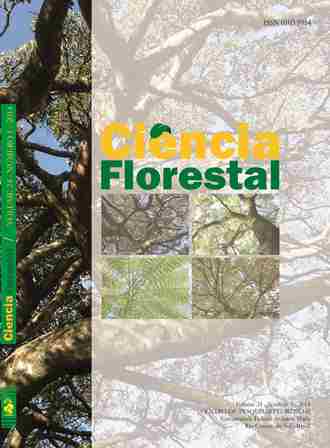PRODUCTIVITY OF AUSTRALIAN CEDAR MINISTUMPS AND NUTRIENTS REMOVAL BY SUCCESSIVE COLLECTION OF MINICUTTINGS
DOI:
https://doi.org/10.5902/1980509813324Keywords:
Toona ciliata, multiclonal minigarden, seedling production.Abstract
The management of ministumps to produce minicuttings results in the continuous removal of nutrients andit is necessary replacement to avoid depletion and decline in production. Thus, it is necessary to determinethe amount of nutrients removed over time, in different management models, to enable commercial mulproduction.The objective of this study was to evaluate two minigarden multiclonal systems of Toonaciliata, in plastic tubes and bed, for productivity and nutrients removal over time by ministumps, producedby seeds, submitted to successive collections of minicuttings. One hundred and eighty-six seedlings wereused in each management system. In this paper, it was determined the nutrient content in shoots issued by20 ministumps randomly selected in each system. Five shoots were collected at intervals of 32 days in bedsystem, while in the plastic tubes system three shoots were collected at intervals of 31 days. The data wereanalyzed by a sample simple random considering an infinite population of minicuttings. The qualitativetreatment average was compared by confidence interval using the Student t test, 5% probability, and thequantitative treatment (productivity and nutrients removed in time by ministumps) by regression. It hasbeen found that the productivity and nutrient contents removed by ministumps in bed were higher than inthe plastic tubes. Nitrogen and potassium are the nutrients most removed by ministumps in both systems.Here, it was presented the curves corresponding to the nutrients exported, to estimate the replacement thatwill be made in each system over time.Downloads
References
AZEVEDO, E. B. et al. Substratos fertilizados com uréia revestida e o crescimento e estado nutricional da muda de citros. Acta Scientiarum. Agronomy, Maringa, v. 31, n. 1, p. 129-137, 2009.
CUNHA, A. C. M. C. M.; WENDLING, I.; JÚNIOR, L. S. Produtividade e sobrevivência de minicepas de Eucalyptus benthamii Maiden et Cambage em sistema de hidroponia e em tubete. Ciência Florestal. Santa Maria, v. 15, n. 3, p. 307-310, 2005.
CUNHA, A. C. M. C. M.; WENDLING, I.; JÚNIOR, L.S. Miniestaquia em sistema de hidroponia e em tubetes de corticeira-do-mato. Ciência Florestal, Santa Maria, v. 18, n. 1, p. 85-92, 2008.
GARLET, T. M.B.; SANTOS, O. S. (2008) Solução nutritiva e composição mineral de três espécies de menta cultivadas no sistema Hidropônico. Ciência Rural, Santa Maria, v. 38, n. 5, p. 1233-1239, 2008.
HIGASHI, E. N.; SILVEIRA, R. L. V. de A.; GONÇALVES, A. N. (2000) Propagação Vegetativa de Eucalyptus: Princípios Básicos e a sua Evolução no Brasil. Circular Técnica IPEF, n. 192, 2000. 10p.
HIGASHI, E. N.; SILVEIRA, R. L. V. de A.; GONÇALVES, A. N. Nutrição e Adubação em Minijardim clonal hidropônico de Eucalyptus. Circular Técnica IPEF, n. 194, 2002. 21p.
LIAO, S. et al. Limonoids from the Leaves and Stems of Toona ciliata. Journal of Natural Products, Shanghai, v. 70, n. 8, p. 1268-1273, 2007.
MALAVOLTA, E.; VITTI, G. C.; OLIVEIRA, S. A. Avaliação do estado nutricional das plantas, princípio e aplicações. 2. ed. Piracicaba: Potafo, 1997. 319 p.
MROGINSKI, E.; REY, H. Y.; MROGINSKI, L. A. (2003) In vitro plantlet regeneration from Australian Red Cedar (Toona ciliata, Meliaceae). New Forest, Netherlands, v. 25, p. 177-184, 2003.
MURAKAMI, C. H. G. Cedro Australiano: Valorização de Espécies Nobres Boletim Florestal, n. 7, 2008. p. 1-10.
PAIVA, Y. G. et al. Zoneamento agroecológico de pequena escala para Toona ciliata, Eucayptus grandis e Eucalyptus urophilla na Bacia Hidrográfica do Rio Itapemirim – ES, utilizando dados SRTM. In: VIII SIMPÓSIO BRASILEIRO DE SENSORIAMENTO REMOTO, 2007, Florianópolis. Anais..., INPE: Florianópolis, 2007, p. 1785-1792.
PINHEIRO, A. L., LANI, L. L., COUTO, L. Cultura do Cedro Australiano para Produção de Madeira Serrada. Viçosa - UFV, 2003. 42p.
ROSA, L. S. et al. Efeito da dose de nitrogênio e de formulações de substratos na miniestaquia de eucalyptus dunnii Maiden. Revista Árvore, Viçosa, v.33, n. 6, p. 1025-1035, 2009.
SOUZA, J. C. A. V. et al. Propagação vegetativa de cedro-australiano (Toona ciliata M. Roemer) por miniestaquia. Revista Árvore, Viçosa, v. 33, n. 2, p. 205-213, 2009.
SOUZA JUNIOR, L.; QUOIRIN, M.; WENDLING, I. Miniestaquia de Grevillea robusta A. Cunn. a partir de propágulos juvenis. Ciência Florestal, Santa Maria, v. 18, n. 4, p. 455-460, 2008.
TITON, M. et al. Eficiência das minicepas e microcepas na produção de propágulos de clones de Eucalyptus grandis. Revista árvore, Viçosa, v. 27, n. 5, p. 619-625, 2003.
WENDLING, I.; DUTRA, L. F.; GROSSI, F. Produção e sobrevivência de miniestacas e minicepas de erva-mate cultivadas em sistema semi-hidropônico. Pesquisa agropecuária brasileira, Brasília, v. 42, n. 2, p. 289-292, 2007.
WENDLING, I.; FERRARI, M. P.; DUTRA, L. F. (2005) Produção de mudas de corticeira-do-mato por miniestaquia a partir de propágulos juvenis. Comunicado Técnico, Colombo/PR, 2005. 5p.
WENDLING, I.; SOUZA JÚNIOR, L. Propagação vegetativa de erva-mate (Ilex paraguariensis Saint Hilaire) por miniestaquia de material juvenil. In: CONGRESSO SUL – AMERICANO DA ERVA-MATE, 2003, Chapecó. Anais..., Epagri: Chapecó, 2003. CD – rom.
XAVIER, A. et al. Propagação vegetativa de cedro-rosa por miniestaquia. Revista Árvore, Viçosa, v. 27, n. 2, p. 139-143, 2003.







